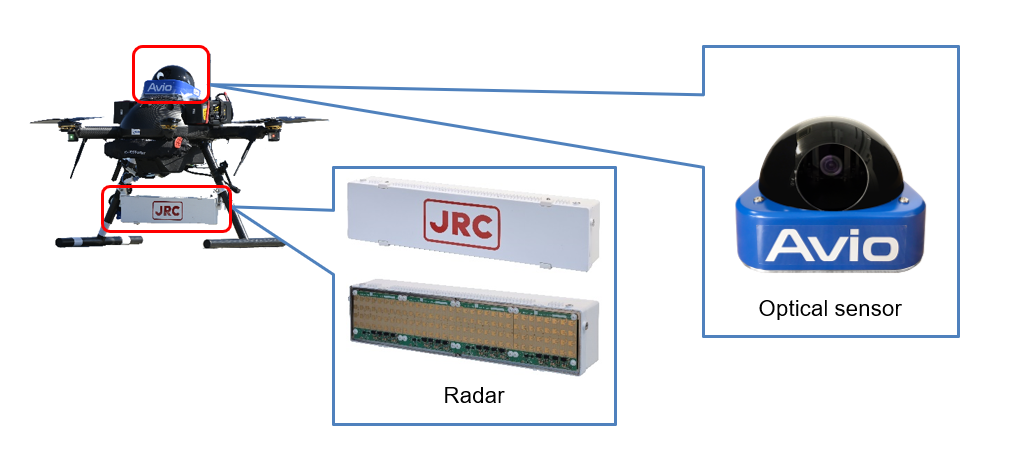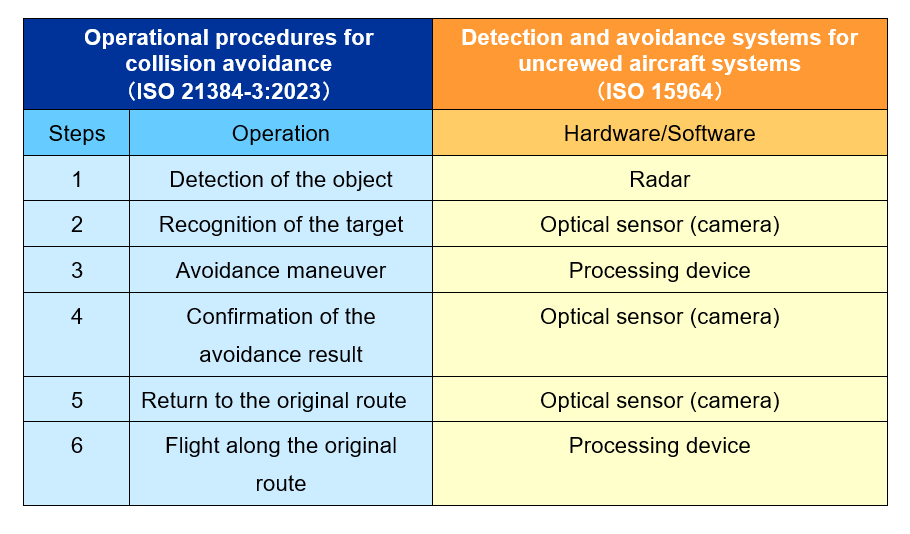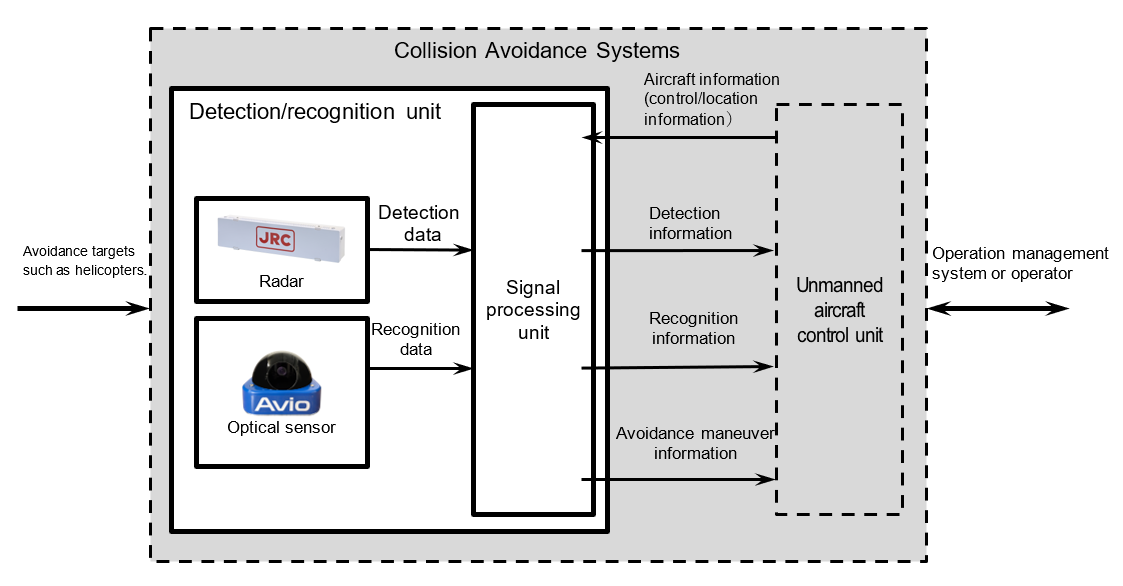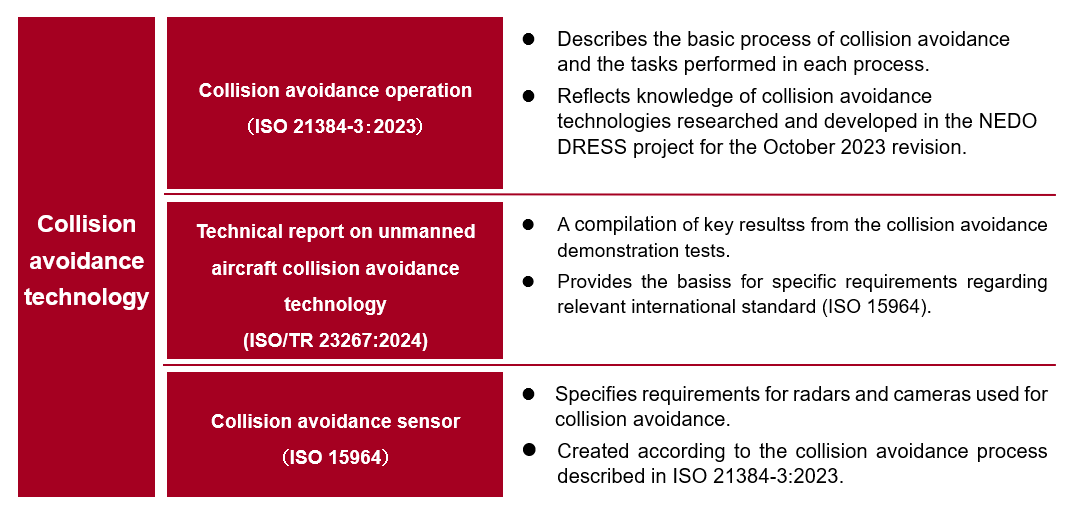- Home
- News Releases
- Back Issues
- May FY2025
- New International Standard for Uncrewed Aircraft Collision Avoidance Systems Issued
New International Standard for Uncrewed Aircraft Collision Avoidance Systems Issued
Aiming for Safer Use of Uncrewed Aircraft (ISO 15964)
May 8, 2025
Uncrewed aircraft (drones) are currently widely used in agriculture and other fields and are expected to be utilized in the future for transporting goods during disasters and searching for people in distress. As the field of utilization of drones expands, the development of technology to avoid collisions with other drones is an urgent issue to be addressed in drones safety. Under the circumstances, an international standard (ISO 15964) for drone collision avoidance systems has recently been issued, for which the Ministry of Economy, Trade and Industry and NEDO provided R&D and standardization support. This is expected to make it possible to unify the direction of development of collision avoidance technology for drones and to accelerate efforts in each country to implement drone use throughout society, leading to the realization of a wide range of services.
1. Background
Small to medium-sized uncrewed aircraft, generally referred to as drones, are currently being widely utilized in the agricultural and other fields and are expected to be utilized in the future for transporting goods during disasters, searching for people in distress, logistics infrastructure, and for other applications. On the other hand, preventing collisions with other crewed aircraft has become an urgent issue for the safe use of drones, as examples of near misses (*1) between drones and crewed aircraft, such as medical helicopters, have been reported in Japan.
Under the circumstances, METI has been working to support the proposal of an international standard on collision avoidance for drones in order to realize a wide range of drone applications within Japan and overseas. Based on the results of research, development, and demonstration tests related to drone collision avoidance technology, for which METI’s support began in 2017 (see Figure 1), in October 2023, the standard for unmanned aircraft operational procedures (ISO 21384-3:2023*2) was revised under Japan's initiative, and in April 2024, the technical report on unmanned aircraft collision avoidance (ISO/TR23267*3) was proposed and published under Japan's initiative.

2. Outline of the international standard
METI and NEDO provided research, development, and standardization support for the recently issued ISO 15964*4. It specifies the basic architecture of a collision avoidance system that embodies the six steps of the basic collision avoidance procedure for uncrewed aircraft (detection of the object, recognition of the target, avoidance maneuver, confirmation of the avoidance result, return to the original route, and flight along the original route). This was newly specified in the 2023 revision of ISO 21384-3:2023 (Standard for operational procedures for unmanned aircraft) (see Table 1 and Figure 2).
In the latest ISO 15964, the roles of various sensor devices and requirements such as detection and recognition distances are specified in relation to each of the six steps above for collision avoidance systems equipped with radar and optical sensors to be installed in uncrewed aircraft. The results of demonstration tests in NEDO's Drones and Robots for Ecologically Sustainable Societies project (DRESS project)*5 and ISO/TR23267, which was published in 2024, were used as the basis for these specifications.



3. Expected effects
This standard is expected to unify the direction of development of collision avoidance technology for drones, accelerate the efforts of each country in implementing drones within society, and lead to the realization of a wide range of services.
*1 Examples of near misses with crewed aircraft (in Japanese)
See Measures to Avoid Collisions between Aircraft and Unmanned Aircraft, and between Unmanned Aircraft (Civil Aviation Bureau, Ministry of Land, Infrastructure, Transport and Tourism, November 8, 2016) p. 16.![]()
*2 ISO 21384-3: 2023
Unmanned aircraft systems Part 3: Operational procedures![]()
*3 ISO/TR 23267
Experiment results on test methods for detection and avoidance (DAA) systems for unmanned aircraft systems![]()
*4 ISO 15964
Detection and avoidance systems for uncrewed aircraft systems![]()
*5 Drones and Robots for Ecologically Sustainable Societies project (NEDO DRESS project)
The project that NEDO has been promoting since 2017, with the aim of realizing an energy-saving society through the following four items: [1] Development of performance evaluation methods for robot and drone devices; [2] Development of drone traffic management systems and collision avoidance technology; [3] Promotion of international standards related to robots and drones; and [4] Leading research study on flying vehicles(in Japanese).![]()
*6 Reflection of NEDO DRESS project results in ISO standards
Report on FY2023 Results. Prepared by Japan Radio Co., Ltd., based on the information gathering expenses/survey of case studies contributing to the strategic use of standards at NEDO.
See the following URL for the result report: URL (in Japanese)![]()
Related websites
- ISO Portal page for the standards (ISO 15964:2025)

- New Energy and Industry Technology Development Organization (NEDO)

Divisions in Charge
For international standards
International Standardization Division, Innovation and Environment Policy Bureau
For Drones and Robots for Ecologically Sustainable Societies project
Advanced Air Mobility Office, Aerospace and Defense Industry Division, Manufacturing Industries Bureau